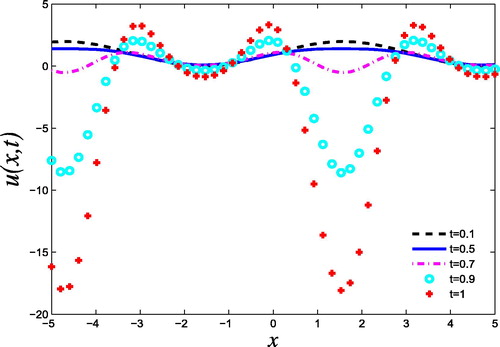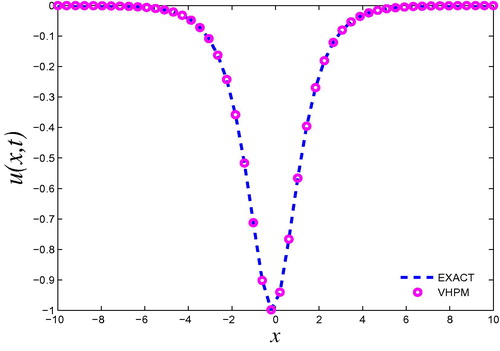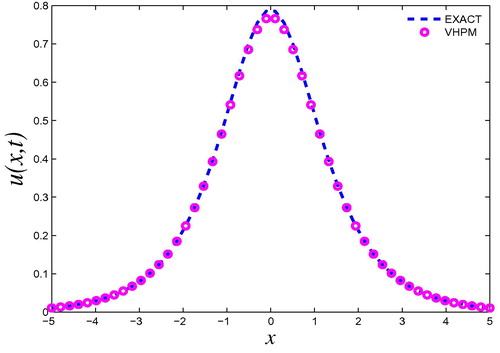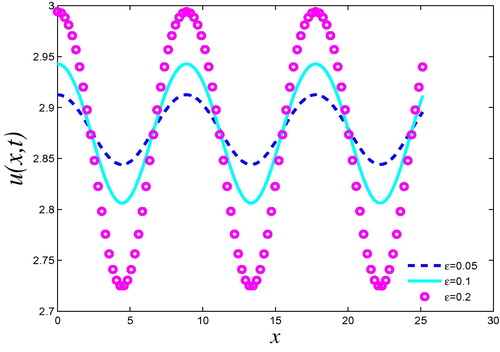Abstract
In this paper, we practiced relatively new, analytical method known as the variational homotopy perturbation method for solving Klein–Gordon and sine-Gordon equations. To present the present method’s effectiveness many examples are given. In this study, we compare numerical results with the exact solutions, the Adomian decomposition method (ADM), the variational iteration method (VIM), homotopy perturbation method (HPM), modified Adomian decomposition method (MADM), and differential transform method (DTM). The results reveal that the VHPM is very effective.
1 Introduction
Differential equations can model many physics and engineering problems especially the nonlinear differential equations, but to reach exact solutions is not an easy way. Therefore analytical methods have been used to find approximate solutions. In recent years, many analytical methods such as Variational iteration method (He, Citation1999b; Muhammad and Syed, Citation2008; Zayed and Abdel Rahman, Citation2010b"), and modified variational iteration method (Zayed and Abdel Rahman, Citation2009, Citation2010a") and variational homotopy perturbation method (Fadhil et al., Citation2015; Matinfar et al., Citation2010; Matinfar and Ghasemi, Citation2010") have been utilized to solve linear and nonlinear equations. The Klein–Gordon and sine-Gordon equations are a two non-linear hyperbolic partial differential equations, which are model problems in classical and quantum mechanics, solitons, and condensed matter physics.
Let us consider the Klein–Gordon and sine-Gordon equation, respectively,(1) and
(2) subject to initial conditions
(3) where u is a function of x and
is a nonlinear function, f is a known analytic function, and
are constants.
In recent years, there has appeared an ever increasing interest of scientist and engineers in analytical techniques for studying Klein–Gordon and sine-Gordon equations. The Klein–Gordon equation was solved by many analytical methods such as variational iteration method (Elcin, Citation2008; Semary and Hassan, Citation2015") differential transform method (Ravi Kanth and Aruna, Citation2009), the decomposition method (El-Sayed, Citation2003), homotopy perturbation method (Chowdhury and Hashim, Citation2009), new homotopy perturbation method (Biazar and Mostafa, Citation2014), Local fractional series expansion method (Yang et al., Citation2014), and the tanh and the sine-cosine methods (Wazwaz, Citation2005). Also, the sine-Gordon equation has been solved analytically by modified decomposition method (Kaya, Citation2003), variational iteration method (Batiha, Citation2007; Abbasbandy, Citation2007"), and differential transform method (Biazar and Mohammadi, Citation2010). Recently many authors studied Klein/sine-Gordon equations (see Fukang et al., Citation2015; Chen et al., Citation2014; Dehghan et al., Citation2015").
The goal of the this paper is to solve Klein–Gordon and sine-Gordon equations by applying another powerful analytical method, called the variational homotopy perturbation method (VHPM), the method is a coupling of homotopy perturbation method (He, Citation1999a) and variational iteration method (He, Citation1999b). VHPM was first envisioned by Muhammad and Syed (see Muhammad and Syed, Citation2008). VHPM used to solve many equations such as Higher Dimensional Initial Boundary Value Problems (Muhammad and Syed, Citation2008), Benjamin-Bona-Mahony (Fadhil et al., Citation2015), Zakharove-Kuznetsov equations (Matinfar and Ghasemi, Citation2010), Fishers equation (Matinfar et al., Citation2010), the fractional equations (Guo and Mei, Citation2011), and fractional diffusion equation (Guo et al., Citation2013).
2 Variational Homotopy perturbation Method (VHPM)
To clarify the basic ideas of VHPM, we consider the following differential equation(4) where L is a linear operator defined by
is a nonlinear operator and
is a known analytic function. According to VIM, we can write down a correction functional as follows:
(5) where
is a Lagrange multiplier, which can be identified optimally via a variational iteration method. The subscripts n denote the th approximation,
is considered as a restricted variation. That is,
;. Now, we apply the homotopy perturbation method,
(6)
As we see, the procedure is formulated by the coupling of variational iteration method and homotopy perturbation method. A comparison of like powers of p gives solutions of various orders.
3 Applications
To illustrate the effectiveness of the present method, several test examples are considered in this section.
3.1 Example 1
We consider the linear Klein–Gordon equation(7) subject to the initial conditions
(8)
According Eq. Equation(5)(5) , the correction functional is given by
(9)
Making the above correction functional stationary, and noting that , we get
(10) which yields the following stationary conditions:
(11)
(12)
(13)
Then, the Lagrange multiplier, can be identified as(14)
As a result and Eq. Equation(9)(9) , we get
(15)
Applying the variational homotopy perturbation method, we have(16)
Comparing the coefficient of like powers of p, we have(17)
(18)
Thus solving Eqs. Equation(17)(17) and Equation(18)
(18) , using initial conditions Equation(8)
(8) yields
(19)
(20)
(21)
This shows that the solution is the same as that obtained by ADM El-Sayed (Citation2003), HPM Chowdhury and Hashim (Citation2009), and VIM Elcin (Citation2008).
3.2 Example 2
We consider nonlinear Klein–Gordon equation(22) subject to the initial conditions
(23)
According Eq. Equation(5)(5) , the correction functional of Eq. Equation(22)
(22) is given by
(24) where
is considered as a restricted variation, Its stationary conditions can be obtained as follows:
(25)
(26)
(27) Then, we get
(28)
Substituting Lagrangian multiplier Equation(28)(28) into functional Equation(24)
(24) , we get
(29)
Applying the variational homotopy perturbation method, we have(30)
Comparing the coefficient of like powers of p, we have(31)
(32)
(33)
(34)
Thus solving Eqs. Equation(31)(31) and Equation(34)
(34) , using initial conditions Equation(23)
(23) yields
(35)
(36)
(37)
(38)
Then, the 4-term approximate series solution can be written as(39)
3.3 Example 3
We consider nonlinear Klein–Gordon equation(40) subject to the initial conditions
(41)
The exact solution of Eq. Equation(40)(40) is (see Ref. Zhao et al., Citation2006)
(42)
According Eq. Equation(5)(5) , the correction functional of Eq. Equation(40)
(40) is given by
(43)
Then, the Lagrange multiplier, can be identified as(44)
Substituting Lagrangian multiplier Equation(44)(44) into functional Equation(43)
(43) , we get
(45)
Applying the variational homotopy perturbation method, we have(46)
Comparing the coefficient of like powers of p, we have(47)
(48)
(49)
(50)
(51)
Thus solving Eqs. Equation(47)(47) and Equation(51)
(51) , using initial conditions Equation(41)
(41) yields
(52)
(53)
(54)
(55)
Then, the 4-term approximate series solution can be written as(56)
We compare our results obtained by VHPM and exact solution Equation(42)(42) of Eq. Equation(40)
(40) in and .
Table 1 The absolute error between exact solution Equation(42)(42) and 4-term of VHPM for different values of
.
3.4 Example 4
We consider nonlinear sine-Gordon equation(57) subject to the initial conditions
(58)
The exact solution of Eq. Equation(57)(57) is
(59)
According Eq. Equation(5)(5) , the correction functional of Eq. Equation(57)
(57) and taking
is given by
(60)
Then, the Lagrange multiplier, can be identified as(61)
Substituting Lagrangian multiplier Equation(61)(61) into functional Equation(60)
(60) , we get
(62)
Applying the variational homotopy perturbation method, we have(63)
Comparing the coefficient of like powers of p, we have(64)
(65)
(66)
Thus solving Eqs. Equation(64)(64) and Equation(66)
(66) , using initial conditions Equation(58)
(58) yields
(67)
(68)
(69)
(70)
Hence, the 4-term VHPM solution is(71)
The comparison between absolute errors of exact solution with the 5-terms of modified decomposition method (Kaya, Citation2003), 2-iteration solution of the variational iteration method (Batiha, Citation2007), and 4-iteration solution of variational homotopy perturbation method is given in . Also, we compared between exact solution and approximate solution obtained by variational homotopy perturbation method in .
Table 2 The absolute error between exact solution and 5-term MADM (Kaya, Citation2003), 2-iterate VIM (Batiha, Citation2007) and 4-term VHPM, when and different values of t.
3.5 Example 5
We consider nonlinear sine-Gordon equation(72) subject to the initial conditions
(73)
Same as Example 4. by means VHPM 2-term of solution are(74)
(75)
Then, the approximate solution via VHPM of Eq. Equation(72)(72) is
(76)
We showed the solution obtained by VHPM in . Also, we showed the effectiveness of to the solution.
4 Discussion of results
In this section, we discuss the results obtained by the VHPM for Klein–Gordon sine-Gordon equations.
In Example (3.1), the analytical solution obtained by the VHPM is same as that obtained by the ADM, HPM, and VIM (see Eq. Equation(21)(21) ). Example (3.2) observe the solution via VHPM and showed in at difference time and it is clear that the time effect to the solution. From Example (3.3), we compared the results obtained via VHPM with the exact solution. Also, we found absolute error between exact solution and present work (see and ). In Example (3.4), the results by the VHPM are more accurate than those obtained by MADM and VIM (see and ). Also, the application of the VHPM to Example (3.5), showed that, the parameter
played an important role in initial conditions (see ).
5 Conclusion
In this work, variational homotopy perturbation method is applied to solve the Klein–Gordon and sine-Gordon equations. The present study has confirmed that the variational homotopy perturbation method is effective and suitable for solving these types of linear and nonlinear equations. Also, we showed that the present method has good agreement with other analytical methods such as ADM, VIM, HPM, and MADM.
Acknowledgement
We thank the editor and the referee for their comments.
Notes
Peer review under responsibility of University of Bahrain.
References
- S.AbbasbandyNumerical solution of non-linear Klein–Gordon equations by variational iteration methodInt. J. Numer. Methods Eng.702007876881
- B.BatihaMSMNooraniI.HashimNumerical solution of sine-Gordon equation by variational iteration methodJ. Phys. Lett. A3702007437440
- J.BiazarF.MohammadiApplication of differential transform method to the sine-Gordon equationInt. J. Nonlinear Sci.102010190195
- J.BiazarE.MostafaAnalytical solution of the Klein–Gordon equation by a new homotopy perturbation methodComput. Math. Model.252014124134
- JingChenJieYangHongxiangYangSingle soliton solutions of the coupled nonlinear Klein–Gordon equations with power law nonlinearityAppl. Math. Comput.2462014184191
- M.S.H.ChowdhuryI.HashimApplication of homotopy-perturbation method to Klein–Gordon and sine-Gordon equationsJ. Chaos Solitons Fractals39200919281935
- D.KayaA numerical solution of the sine-Gordon equation using the modified decomposition methodAppl. Math. Comput.1432003309317
- MehdiDehghanMostafaAbbaszadehAkbarMohebbiAn implicit RBF meshless approach for solving the time fractional nonlinear sine-Gordon and Klein–Gordon equationsEng. Anal. Boundary Elem.502015412434
- Y.ElcinThe variational iteration method for studying the Klein Gordon equationJ. Appl. Math. Lett.212008669674
- S.M.El-SayedThe decomposition method for studying the Klein–Gordon equationJ. Chaos Solitons Fractals18200310251030
- H.FadhilA.SaadA.BewarA.MajeedVariational homotopy perturbation method for solving Benjamin–Bona–Mahony EquationAppl. Math. (AM)62015675683
- Y.FukangT.TianS.JunqiangMinZhuSpectral methods using Legendre wavelets for nonlinear Klein/Sine-Gordon equationsJ. Comput. Appl. Math.2752015321334
- ShiminGuoLiquanMeiThe fractional variational iteration method using Hes polynomialsPhys. Lett. A3752011309313
- ShiminGuoLiquanMeiYingLiFractional variational homotopy perturbation iteration method and its application to a fractional diffusion equationAppl. Math. Comput.219201359095917
- J.H.HeHomotopy perturbation techniqueJ. Comput. Methods Appl. Mech. Eng.1781999257262
- J.H.HeVariational iteration method a kind of non-linear analytical technique: some examplesInt. J. Nonlinear Mech.341999699708
- M.MatinfarM.GhasemiVariational homotopy perturbation method for the Zakharove–Kuznetsov equationsJ. Math. Stat.62010425430
- M.MatinfarZ.RaeisiM.MahdaviVariational homotopy perturbation method for the fishers equationInt. J. Nonlinear Sci.92010374378
- A.N.MuhammadT.M.SyedVariational homotopy perturbation method for solving higher dimensional initial boundary value problemsJ. Math. Prob. Eng.2008 Article ID 696734
- A.S.V.Ravi KanthK.ArunaDifferential transform method for solving the linear and nonlinear Klein–Gordon equationJ. Comput. Phys. Commun.1802009708711
- Mourad S.SemaryHany N.HassanA new approach for a class of nonlinear boundary value problems with multiple solutionsJ. Assoc. Arab Univ. Basic Appl. Sci.1720152735
- A.M.WazwazThe tanh and the sine-cosine methods for compact and noncompact solutions of the nonlinear Klein–Gordon equationJ. Appl. Math. Comput.167200511791195
- A.M.YangY.Z.ZhangC.CattaniG.N.XieM.M.RashidiY.J.ZhouX.J.YangApplication of local fractional series expansion method to solve Klein–Gordon equations on cantor setsAbstract Appl. Anal.20142014 Article ID 37274
- Elsayed M.E.ZayedHanan M.Abdel RahmanOn solving the KdV-Burgers equation and the Wu-Zhang equations using the modified variational iteration methodInt. J. Nonlinear Sci. Numer. Simul.10200910931103
- Elsayed M.E.ZayedHanan M.Abdel RahmanOn using the modified variational iteration method for solving the nonlinear coupled equations in the mathematical physicsRicerche Mat592010137159
- Elsayed M.E.ZayedHanan M.Abdel RahmanThe Variational iteration method and the variational homotopy perturbation method for solving the KdV-Burger’s equation and the Sharma–Tasso–Olver equationZeitschrift fur Naturforschung65a20102533
- XueqinZhaoHongyanZhiYaxuanYuHongqingZhangA new Riccati equation expansion method with symbolic computation to construct new travelling wave solution of nonlinear differential equationsJ. Appl. Math. Comput.17220062439




